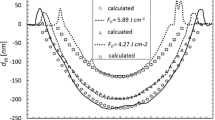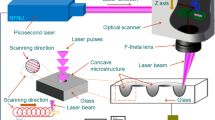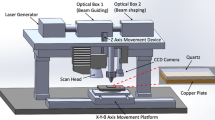Abstract
Glass is widely used for various applications, including flat panel displays, solar panels, architectural windows, and exterior materials. These applications exhibit increasing complexity and improved functionality. In particular, glass substrates used in display panels require diverse forms of processing, prompting the exploration of laser applications to enhance processing quality, yield, and efficiency. This study aims to investigate the feasibility of using a high absorption, 257 nm femtosecond laser for processing glass substrates. The goal is to minimize damage and eliminate the need for post-processing, and ensuring superior quality and cross-sectional features. The analysis focuses on the influence of energy density and laser beam overlap ratio on processing variations. Point, line, and area processing were conducted within the achievable energy density range of 2.4–10.8 J/cm2. The results indicate that as the overlap ratio increases, processing depth, influenced by heat accumulation, exhibits a non-linear growth pattern. Moreover, the phenomenon of excessive processing width, surpassing design specifications, is mitigated by utilizing burst pulses that induce heat accumulation of ultra-short pulse lasers, thereby promoting increased processing depth while restraining width expansion. By comparing the outcomes of glass substrate processing using different laser wavelengths and pulse durations, it is confirmed that employing a 257 nm femtosecond laser minimizes damage, cracks, and chipping in the processed areas, obviating the need for post-processing. This paper presents the pioneering research on glass processing using deep ultraviolet femtosecond lasers. Results indicate that clear glass ablation is achieved without cracks.

















Similar content being viewed by others
References
Jeong, Y., et al. (2019). Flexible coverwindow technology for foladable display. Korean Society for Information Display, 20(4), 71–80.
Samsung Newsroom, Samsung display introduces foldable display with easily bendable, Ultra-thin Glass, news.samsung.com, 02.19.2020.
Samsung Display Newsroom, “UTGTM (Ultra Thin Glass)”, news.samsungdisplay.com, 07.08.2020.
Yang, J.-S. (2021). Next-generation flexible display technology change-focusing on ultra thin glass processing technology. GFS-These_Master, KAIST.
SCHOTT, “SCHOTT UTG® in foldable displays”, www.shott.com
Sisk, S., et al. Corning incorporation Lotus NXT. Corning LotusTM NXT Glass, through its advantaged and balanced glass attributes, was designed to address the challenges of today’s LTPS-OLED manufacturing processes.
Kim, K.-R. (2007). Laser microfabrications for next-generation flat panel display. Korean Journal of Materials Research, 17(7).
Butkute, A., et al. (2021). Optimization of selective laser etching for glass micromechanical structure fabricatio. Optics Express, 29(15), 23486.
Ross, C. A., et al. (2018). Optimisation of ultrafast laser assisted etching in fused silica. Optics Express, 26(19), 24343.
Bellouard, Y., et al. (2022). Glass-in-glass infiltration for 3D micro-optical composite components. Optics Express, 30(8), 13603.
Dietrich, T. R., et al. (1996). Fabrication technologies for microsystems utilizing photoetchable glass. Microelectronic Engineering, 30, 497–504.
Hanada, Y., Sugioka, K., & Midorikawa, K. (2007). Selective metallization of photostructurable glass by femtosecond laser direct writing for biochip application. Applied Physics A, 90, 603–607.
Cho, K., Kim, Y. (2015). Glass cutting process using short pulse laser. In Proceedings of ALTA.
Gattass, R., & Mazur, E. (2008). Femtosecond laser micromachining in transparent materials. Nature Photonics, 2(4), 219–225.
Choi, J., Cho, S. H., Suh, J., Lee, J. H. (2011). Micromachining of glass using an ultrashort pulse laser. In Proceedings of KSPE, spring conference, pp. 151–152.
Lee, J.-H., Suh, J., Sohn, H.-K., & Shin, D.-S. (2006). Trends in micromachining technology using ultrashort pulse laser. Journal of KWS, 24(1), p26–p32.
Shin, Y. G., Choi, J., & Cho, S. H. (2022). Morphologies of cemented tungsten carbides irradiated by femtosecond laser with high pulse energy for machining enhanced cutting tools. International Journal Precision Engineering, 24(4), 547–553.
Yamamuro, Y., Shimoyama, T., & Yan, J. (2022). Microscale surface patterning of zirconia by femtosecond pulsed laser irradiation. International Journal Precision Engineering, 9(2), 619–632.
Stuart, B. C., et al. (1996). Nanosecond-to-femtosecond laser-induced breakdown in dielectrics. Physical Review B, 53(4), 1749.
Shugaev, M. V. et al. (2016). Fundamentals of ultrafast laser-material interaction. MRS Bulletin, 41.
Kruer, J., et al. (2004). Ultrashort pulse laser interaction with dielectrics and polymers. Advances in Polymer Science, 168, 247–289.
Apte, P., Sykes, N. (2015). Pulsed UV and ultrafast laser micromachining of surface structures. In Proceedings of SPIE, vol. 9657.
Garner, S., Glaesemann, S., Li, X. (2014). Ultra-slim flexible glass for roll-to-roll electronic device fabrication. Applied Physics A.
Hoffman, J., et al. (2014). The effect of laser wavelength on the ablation rate of carbon. Applied Physics A, 117, 395–400.
Sisk, S., Koh, J., Su., P. H., Bowden, B. Corning LotusTM NXT glass, through its advantaged and balanced glass attributes, was designed to address the challenges of today’s LTPS-OLED manufacturing processes. Corning Incorporated, Corning, white paper.
Kobayashi, M., et al. (2017). DUV high power lasers processing for glass and CFRP. In High-power, high-energy, and high-intensity laser technology III, vol. 10238. International Society for Optics and Photonics.
Ben-Yakar, A., & Byer, R. L. (2004). Femtosecond laser ablation properties of borosilicate glass. Journal of Applied Physics, 96(9), 5316–5323.
Kim, K.-R. (2008). Femto-second laser glass cutting for flat panel display. MRSK, 18(5), 247.
Lee, S. K., et al. Processing evaluations of eagle glass cutting using pico-second laser. Journal of the Korean Society for Precision Engineering 30(4), 403–408
Mishchick, K., Hoenninger, C., Mottay, E., et al. (2017) Glass cutting with femtosecond pulsed: Industrial approach with beam engineering. LIM.
Eaton, S. M., Zhang, H., & Herman, P. R. (2005). Heat accumulation effects in femtosecond laser-written waveguides with variable repetition rate. Optics Express, 13(12), 4708.
Tan, D., Zhang, Bo., & Qiu, J. (2021). Ultrafast laser direct writing in glass: Thermal accumulation engineering and applications. Laser & Photonics Reviews, 15(9), 2000455.
Jenne, M., Nolte, S., et al. (2020). Facilitated glass separation by asymmetric Bessel-like beams. Optics Express, 28(5), 6552.
Choi, J., et al. (2020). A study of femtosecond laser ablation threshold on several materials using fiber optic beam delivery system. Journal of the Korean Society for Precision Engineering, 37(12), 1–8.
Lope, J., et al. (2013). Study on the influence of repetition rate and pulse duration on ablation efficiency using a new generation of high power Ytterbium doped fiber ultrafast laser. Frontiers in Ultrafast Optics : Biomedical, Scientific, and Industrial Applications XIII, 8611, 131–144.
Zhang, H., van Oosten, D., Krol, D. M., & Dijkhuis, J. I. (2011). Saturation effects in femtosecond laser ablation of silicon-on-insulator. Applied Physics Letters, 99, 231108.
Gao, M., et al. (2017). Observation and understanding in laser welding of pure titanium at sub atmospheric pressure. Optics Express, 25(12), 13539.
Esser, D., et al. (2011). Time dynamics of burst-train filamentation assisted femtosecond laser machining in glasses. Optics Express, 19(25), 25632–25642.
Choi, J., et al. (2007). Increase of ablation rate using burst mode femtosecond pulses. In Conference on lasers and electro-optics. Optical Society of America.
Author information
Authors and Affiliations
Corresponding author
Additional information
Publisher's Note
Springer Nature remains neutral with regard to jurisdictional claims in published maps and institutional affiliations.
Rights and permissions
Springer Nature or its licensor (e.g. a society or other partner) holds exclusive rights to this article under a publishing agreement with the author(s) or other rightsholder(s); author self-archiving of the accepted manuscript version of this article is solely governed by the terms of such publishing agreement and applicable law.
About this article
Cite this article
Cho, K., Choi, J., Ko, C. et al. 257 nm Deep UV Femtosecond Laser Ablation with Minimized Crack and Chipping on Display Ultra-Thin Glass. Int. J. Precis. Eng. Manuf. 25, 271–283 (2024). https://doi.org/10.1007/s12541-023-00929-x
Received:
Revised:
Accepted:
Published:
Issue Date:
DOI: https://doi.org/10.1007/s12541-023-00929-x




